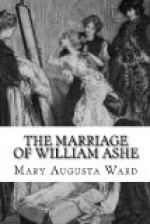Madame d’Estrees raised her shoulders this time in addition to her eyes. Then her face clouded.
“I believe,” she said, slowly, “that woman may come here this afternoon.”
“Is she a friend of yours?” Harman’s tone expressed his surprise.
“I knew her in Paris,” said Madame d’Estrees, with some hesitation, “when she was a student at the Conservatoire. She and I had some common acquaintance. And now—frankly, I daren’t offend her. She has the most appalling temper!—and she sticks at nothing.”
Harman wondered what the exact truth of this might be, but did not inquire. And as guests—including Colonel Warington—began to arrive, and Donna Laura appeared and began to dispense tea, the tete-a-tete was interrupted.
Donna Laura’s salon was soon well filled, and Harman watched the gathering with curiosity. As far as it concerned Madame d’Estrees—and she was clearly the main attraction which had brought it together—it represented, he saw, a phase of social recovery. A few prominent Englishmen, passing through Venice, came in without their wives, making perfunctory excuse for the absence of these ladies. But the cosmopolitans of all kinds, who crowded in—Anglo-Italians, foreign diplomats, travellers of many sorts, and a few restless Venetians, bearing the great names of old, to whom their own Venice was little more than a place of occasional sojourn—made satisfactory amends for these persons of too long memories. In all these travellers’ towns, Venice, Rome, and Florence, there is indeed a society, and a very agreeable society, which is wholly irresponsible, and asks few or no questions. The elements of it meet as strangers, and as strangers they mostly part. But between the meeting and the parting there lies a moment, all the gayer, perhaps, because of its social uncertainty and freedom.
Madame d’Estrees was profiting by it to the full. She was in excellent spirits and talk; bright-rose carnations shone in the bosom of her dress; one white arm, bared to the elbow, lay stretched carelessly on the fine cut-velvet which covered the gilt sofa—part of a suite of Venetian Louis Quinze, clumsily gorgeous—on which she sat; the other hand pulled the ears of a toy spaniel. On the ceiling above her, Tiepolo had painted a headlong group of sensuous forms, alive with vulgar movement and passion; the putti and the goddesses, peering through aerial balustrades, looked down complacently on Madame d’Estrees.
Meanwhile there stood behind her—a silent, distinguished figure—the man of whom Harman saw that she was always nervously and sometimes timidly conscious. Harman had been reading Moliere’s Don Juan. The sentinel figure of Warington mingled in his imagination with the statue of the Commander.
Or, again, he was tickled by a vision of Madame d’Estrees grown old, living in a Scotch house, turreted and severe, tended by servants of the “Auld Licht,” or shivering under a faithful minister on Sundays. Had she any idea of the sort of fold towards which Warington—at once Covenanter and man of the world—was carrying his lost sheep?




